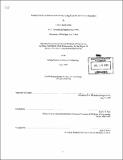Product family architecture modularity using function and variety heuristics
Author(s)
Zamirowski, Erik J. (Erik John), 1973-
DownloadFull printable version (9.413Mb)
Other Contributors
Massachusetts Institute of Technology. Dept. of Mechanical Engineering.
Advisor
Kevin N. Otto.
Terms of use
Metadata
Show full item recordAbstract
This thesis examines the market and functional aspects of developing a product portfolio architecture. Product use based market analysis of customer needs and product features is performed to determine the set of portfolio target values. The variation in these target values among and within customers is interpreted to yield a portfolio architecture recommendation for each feature. Correlation analysis is used to reduce the combinatorial complexity of target values according to market trends. Functional representation of a product portfolio is achieved through a monolithic function structure created by combining individual product use function structures. This function structure is partitioned into function clusters, representing potential module options, using a set of function modularity and variety modularity heuristics. The function modularity heuristics reveal relationships among the product functions according to the interconnection and causality of the functions. The variety heuristic, through which product features are mapped to the functions that deliver them, reveals the potential for variety-dependent modularity. The set of function clusters is compared to determine the degree of interaction among them. When variety function clusters are not orthogonal to each other, the portfolio architecture rules must be modified to compensate for this coupling, or portfolio variety will be compromised. An algorithm is used to reconcile interactions among the function clusters to maximize portfolio variety. The result is a set of function clusters for candidate product modules that achieves the best product variety given functional constraints. The process is exemplified using a portfolio of xerographic products.
Description
Thesis (S.M.)--Massachusetts Institute of Technology, Dept. of Mechanical Engineering, 1999. Includes bibliographical references (leaves 83-84).
Date issued
1999Department
Massachusetts Institute of Technology. Department of Mechanical EngineeringPublisher
Massachusetts Institute of Technology
Keywords
Mechanical Engineering.